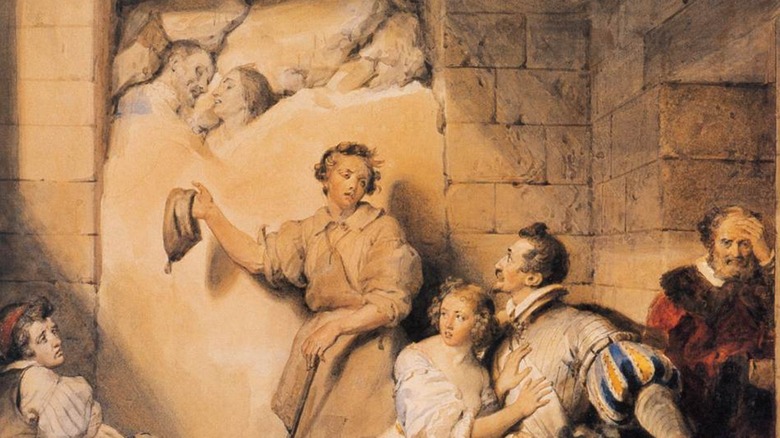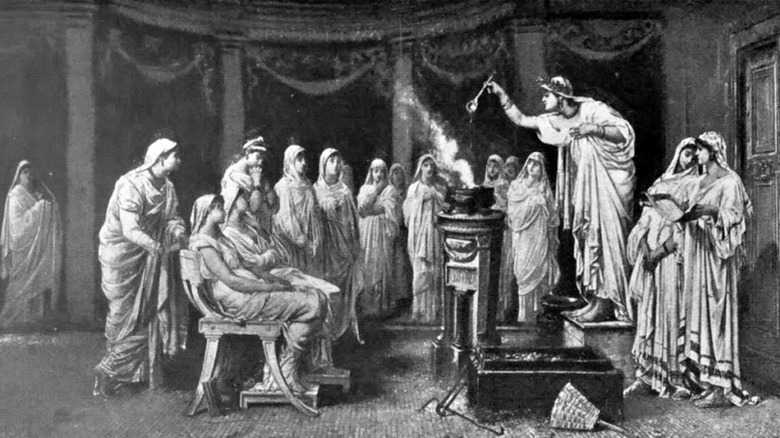The Dark History Of Death By Immurement
Fans of Edgar Allan Poe will recall the creatively gruesome methods of torture he described in his short stories: the slow-strafing swing of a bladed pendulum lowered toward a prisoner's gut in "The Pit and the Pendulum" (1842); blood-sweating aristocracy crippled by the plague of the Red Death in "The Masque of the Red Death" (1842); the drip-drop torture of sealing a chained victim behind a wall brick-by-brick in "The Cask of Amontillado" (1846). Except, guess what? No matter that Poe clearly needed a really big hug to interrupt his brooding; that last piece of sadism wasn't something he made up.
Immurement, by its official name, had been catalogued by Roman historians as a form of capital punishment dating back to as early as 715 BCE (per National Geographic), when king Numa Pompilius founded the order of the goddess Vesta (more on them later). But given the overall human tendency towards abjectly cruel torture, as documented on Britannica, it's not too hard to imagine that immurement existed for far longer.
After all, it's rather simple: Lock someone in a box and let them die. Or build an encasement around them from the ground up and let them die.
The torture and slow execution of being sealed up alive
Immurement was a common form of torture and capital punishment not only in medieval Europe, but across the world all the way through the 20th century. If the intent was to torment someone for a longer time, as All That's Interesting says, the victim was fed food and water through a tiny hole, sometimes for days, weeks or even months. Otherwise, they just stayed there and urinated and defecated, and spoke to no one until the food and water stopped and they wasted away in agony.
One famous 1409 immurement featured four Bavarian clerics in Germany, each sealed in a coffin suspended in mid-air after they were found guilty of sexually abusing children. Immurement was also a common punishment for nuns or monks who disobeyed vows of chastity or "expressed heretical ideas." Even King Richard II, the mad and tyrannical monarch of England deposed in 1399, is said to have died from starvation due to immurement in Pontefract Castle in 1400. Meanwhile, as another All That's Interesting article states, 17th-century merchant Jean Baptiste Tavernier described Persian thieves "encased in ... stone up to their necks," exposed to the elements and scavenging birds. Traveler M. E. Hume-Griffith, also in Persia, wrote between 1900 and 1903 of men "groaning and calling for water" while walled in stone pillars. Most distressing of all, children were sometimes immured in the foundations of castles in the belief that it made the castles invulnerable.
Vestal Virgins were immured for breaking vows
The first recorded instance of immurement goes back to priestesses of ancient Rome called Vestal Virgins. Their order, consecrated in 715 BCE by Numa Pompilius, a king of Rome predating its birth as a republic, worshipped the goddess Vesta (Hestia to the Greeks) and symbolized her role in hearth and home, as National Geographic explains. In a strange parallel to visions of 1950s black-and-white Americana homemakers, Vesta represented "domestic tranquility," which meant cooking, cleaning, communal family time, and in Vesta's case, being so wondrously pure as to remain a perpetual virgin. Born of the titans Kronos and Rhea, she begged her brother Jupiter (Zeus to the Greeks) to let her remain a virgin forever after Apollo and Neptune began squabbling over her beauty, as World History recounts.
The priestesses of Vesta emulated their goddess and carried on her traditions. They resided in the Atrium Vestae in the Roman Forum, which included six full-time residents. Among their duties was tending to the sacred fire of Vesta. Every year in March they relit the flame and ensured it burned for a year, lest disaster consume Rome. And yes, as their name implies, they took 30-year vows of chastity once inducted between the ages of 6 and 10, as World History explains.
If Vestals broke their vow of celibacy, they were executed by immurement, because Roman laws disallowed citizens from being buried within the city. Their partners were whipped to death.


